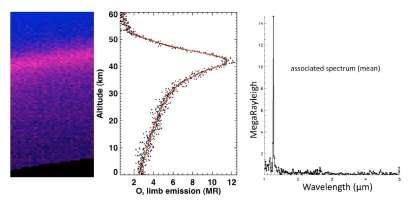A glow in the Martian night throws light on atmospheric circulation

(PhysOrg.com) -- A faint, infrared glow above the winter poles of Mars is giving new insights into seasonal changes in the planet's atmospheric circulation. The tell-tale night emission was first detected in 2004 in observations made by the OMEGA imaging spectrometer on ESA's Mars Express orbiter.
Writing in a recent issue of the Journal of Geophysical Research, a team of French scientists reported on the first detection of an infrared emission above the polar regions of Mars. The emission, at a wavelength of 1.27 microns, was detected on three occasions (in 2004, 2005 and 2006) during a series of 40 observations made by OMEGA above the planet's limb.
Infrared emissions are not unusual in planetary atmospheres. In the upper atmospheres of both Venus and Mars, carbon dioxide (CO2) and nitrogen (N2) molecules are split or photodissociated by solar ultraviolet (UV) light. This produces oxygen and nitrogen atoms in the region known as the thermosphere, at an altitude of about 80-90 km above each planet's dayside.
Spacecraft observations show that the thermospheric circulation of Venus is characterised by a strong flow of air from the warmer, sub-solar point (local midday) toward the anti-solar point (local midnight). The cooler gas on the night side then begins to descend.
As the sinking gas comes into contact with carbon dioxide molecules in the atmosphere, the atoms of oxygen and nitrogen recombine. This recombination process results in an ultraviolet nightglow from nitric oxide (NO), as well as a near-infrared oxygen (O2) emission at 1.27 microns.
A comparable NO emission in the atmosphere of Mars was detected by the SPICAM instrument on Mars Express in 2005. Since this was also attributed to atmospheric circulation, scientists expected to see the associated O2 emission, but the nighttime glow from excited molecular oxygen was not confirmed until the OMEGA observations first reported in 2010.

"We think that the faintness of the infrared oxygen emission over the nightside of Mars may result from the slower descent of the cold air – which means less recombination of the oxygen atoms – and a less intense bombardment by solar UV light, which reduces the rate of photodissociation," explained Jean-Loup Bertaux from LATMOS / Université de Versailles Saint-Quentin, who was lead author of the paper.
The authors believe that the natural light emissions from the atmosphere are clearly associated with the planet's atmospheric circulation. Although few direct observations of Martian high level winds have been made, it is believed that air rises above the warmer, summer pole, moves across the equator and then descends near the winter pole, on the planet's night side. This circulation apparently takes the form of a simple Hadley cell, very much like the atmospheric motion which occurs on either side of Earth's equator.
As predicted by general circulation models of Mars, all of the OMEGA oxygen nightglow observations were obtained at high latitudes, during the winter night. This location coincides with the region where cooler gas is sinking above the pole which is experiencing long-term darkness – similar to the winter pole on Earth.
"When exposed to solar UV radiation above an altitude of 70 km, carbon dioxide molecules - the main atmospheric constituent of Mars' atmosphere - are split into carbon monoxide and oxygen atoms," said Jean-Loup Bertaux.
"Those oxygen atoms are transported by a gigantic Hadley cell, which features an ascending branch above the daytime summer pole and a descending branch over the winter pole, which is in the night hemisphere. The oxygen atoms recombine into molecular oxygen in the descending branch of the Hadley cell, at an altitude of 30-50 km."
Further observations are required to confirm what happens around the time of the Martian equinoxes, when the Sun is overhead at the equator and neither pole is in darkness. Around those dates, the OMEGA data and the general circulation model show that a different pattern establishes, with two symmetrical Hadley cells. Air rises near the equator, and divides into two branches, one going north and the other going south, with air descending simultaneously over both poles.
The paper also addresses whether OMEGA nightglow observations may help to solve the mystery of Martian methane. Although it is easily destroyed by solar UV, the gas is still present on the red planet today.
The authors consider the impact of Hadley circulation on the long-term stability of methane and conclude that recycling of the atmosphere at high altitude seems far too slow to significantly decrease the lifetime of the gas near the surface.
"These findings provide important constraints on the overall aeronomy and atmospheric dynamics of Mars," said Olivier Witasse, ESA's project scientist for Mars Express. "They should also stimulate research into Earth's atmosphere, through comparisons of the processes influencing the global circulations of the two neighbouring planets."
More information: Bertaux, J.-L., et al., "First detection of O2 1.27 µm nightglow emission at Mars with OMEGA/MEX and comparison with general circulation model predictions", J. Geophys. Res., 117, E00J04, 2012. doi:10.1029/2011JE003890
Gondet, B., et al., "O2 nightglow emission detected in Mars atmosphere by OMEGA/Mars Express", paper presented at the European Geosciences Union General Assembly, Vienna, 3 May, 2010.
Clancy, R. T., et al., "CRISM limb observations of O2 singlet delta nightglow in the polar winter atmosphere of Mars", Bull. Am. Astron. Soc., 42, 1041 2010. adsabs.harvard.edu/abs/2010DPS....42.4202C
Provided by European Space Agency




















